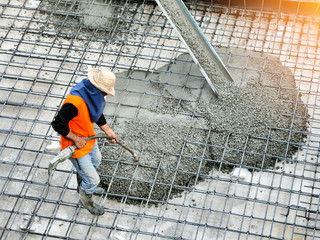A concrete patio is a low-cost way to upgrade your backyard. A basic concrete slab with a standard finish costs $4 to $10 per square foot.
Pouring a concrete patio requires precision and special equipment. Hire a pro like Concrete Contractors Colorado Springs to save time and ensure the work is done correctly. They’ll know how to remove sod and landscaping, as well as grade the site to get it ready for concrete.
A concrete patio can be a utilitarian slab or a design element that enhances your backyard. Thanks to modern coloring techniques and stamping tools, it is possible to make a poured-in-place patio look like anything, from pavers to bricks or stones. Concrete also offers a more uniform appearance than natural stone and can often be installed at a lower cost.
You can purchase pre-mixed concrete bags from a home improvement store, have them delivered by truck, or mix your own at the job site. Buying premixed is the easiest option, but mixing your own provides better quality control and is the cheapest. You will need the following materials to excavate and prepare your concrete patio:
Once the concrete has drained, you can move it into place and finish it. If you choose to use a colorant in your concrete mix, you can add it to the wet concrete and spread it out evenly using a float. Then, you can stamp or etch the surface to create patterns or a unique appearance. You can also sand down the concrete and apply an acrylic cure and sealer for a finished appearance.
Concrete patios are an affordable paving solution for a stylish backyard retreat. They can be shaped and textured to complement your landscape and house, and they can be made to accommodate other features such as fountains, pools, seating areas, and gardens. If your concrete patio is exposed to sunlight all day, it will be wise to reseal the surface regularly to avoid discoloration or cracking.
The most simple way to transform a concrete patio is by adding some plants. Plants not only bring a pop of green but can also help mask any cracks or damage to the surface. Another inexpensive but effective way to give a concrete patio a facelift is by laying a large outdoor rug over it. Concrete will easily accept the rug, and it can cover up any unevenness or patches of gray. The rug will also help to muffle any sounds created by people walking on the hard, concrete surface.
Aggregate
Concrete is commonly used to create a patio, and it is usually smoothed out so that any rough materials included in the mixture are not visible. This kind of paving material is quite popular among homeowners because it is affordable and has an appealing exterior. However, if you want to give your outdoor living space a more distinctive look, consider a concrete patio with an exposed aggregate finish. This type of paved surface is made using a similar mixture as regular concrete but has an added layer of gravel and sand that is exposed on top of the finished product.
Exposed aggregate can be used for a variety of different applications, but it is ideal for patios because of its beautiful aesthetic and slip-resistant surface. It is also available in a wide range of colors, making it easy to match your patio with the rest of your property. In addition, it is very easy to maintain compared to other types of paving materials.
Although exposed aggregate is more expensive than plain concrete, it is a good choice for those who are looking for a unique and attractive outdoor living space. It is more durable and resistant to stains than pavers, and it can withstand heavier foot traffic than most other paving options. In addition, it can be resealed every three to five years for protection and preservation.
This trendy backyard patio features a cozy exposed aggregate concrete surface that looks great with the wooden furniture set and garden pavilion. The patio’s color theme matches the wooden structures of the house, so it has a cohesive and attractive appearance. This patio is also perfect for relaxing or having a casual meal with family and friends.
These cost estimates are based on basic work performed by qualified trade professionals in serviceable conditions with mid-grade materials. Work not mentioned on this page or that requires master craftsmen, premium materials, project supervision, or other non-standard labor and materials will result in higher costs. Contact a professional contractor to get a customized estimate for your specific project.
Water
A concrete patio needs to be durable and able to withstand a variety of weather conditions, including rain, wind, sun, possible freeze-thaw cycles, and temperature variations. It also must be strong enough to hold a large amount of weight and attractive, with a polished finish that is easy to clean. A concrete mix with the right amount of aggregate will give your patio a finished look and feel.
Water ponding on a concrete patio is not only unsightly, but it can cause damage to the surface and lead to other problems with your outdoor space. It’s essential to know what causes it and how to deal with the problem promptly to preserve your patio.
The most common cause of water ponding on a concrete patio is poor drainage. If your patio isn’t sloping properly, it won’t be able to drain water off the surface. You can remedy this by regrading the area around your patio and adding a French drain or channel drain to redirect the water flow.
Other causes of water ponding in a concrete garden include an incorrect slope, damaged concrete, and improper maintenance. It’s important to inspect your patio regularly for cracks and damage. If you notice damage to your patio, repair it as soon as possible with concrete patching materials or resurfacing products to prevent further damage and ponding.
Regular cleaning with a mild detergent and warm water is the best way to maintain your concrete patio. If stains persist, try using muriatic acid to remove stubborn mineral, oil, or rust stains from concrete. Be sure to wear appropriate protective gear and follow the manufacturer’s instructions when working with this chemical. To keep your concrete patio looking its best, apply a waterproof sealant after cleaning it. You can find a wide range of concrete coatings at home improvement centers that are designed to protect your concrete from moisture and other damaging elements. This will help prevent future water ponding and keep your concrete patio looking new. You can also enhance the visual appeal of your concrete patio by adding a fountain or water feature to the area. These can be incorporated at the construction stage or added later as a freestanding decorative element.
Design
Concrete patios can be molded to look like a variety of different types of outdoor structures, including stone and other popular materials. The versatility of the material, combined with advancements in coloring techniques and textured overlays, allows you to customize your concrete patio to suit your taste and to match other aspects of your home’s design.
The pattern of bricks laid on the patio surface can also be customized to fit your style and make the area more attractive. The most common is a running bond pattern, which is ideal for beginners since it doesn’t require any brick cutting. If you’re going for a more decorative pattern, try the stack bond, which looks very attractive and requires minimal cutting.
You can also create a more natural-looking patio by using pavers in earthy colors such as light tan or neutral brown. These shades reflect the sunlight and brighten the patio area, making the space feel larger and more luminous. Additionally, these hues complement the color palette of cool-toned concrete patios and can be easily matched with wood or timber highlights in your home.
Adding plants and trees to your outdoor patio can add a natural element and create a beautiful visual contrast with the concrete elements. A mix of shrubs and flowering bushes is an effective way to incorporate greenery, as they are both fragrant and colorful. Using warm beige and white tones for furniture, rugs, and other decorations is another way to complement the cool tones of concrete patios and create a more inviting space for lounging and entertaining.
Many homeowners choose to pair their concrete patios with alternative materials in order to add character and flair to the space. One popular option is to use stone in the form of paving stones or accents, which add texture and an element of contrast to the otherwise smooth concrete surface.
For a more modern look, you can incorporate metal into your patio design by using metal furniture or railings. This will give your patio a clean, sleek, and sophisticated appearance that can be the perfect backdrop for outdoor parties and other events.

